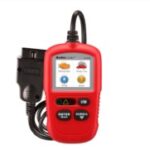Experiencing an OBD scanner failure on your 2003 Honda Accord can be frustrating, especially when it’s related to emissions testing. Often, a “fail” isn’t due to a faulty scanner, but rather because your vehicle’s readiness monitors aren’t set. These monitors are crucial for passing smog tests, and they need to complete their diagnostic cycles. If your 2003 Honda Accord OBD scanner is indicating issues, performing an OBD-II drive cycle might be the solution to get those monitors ready.
The OBD-II drive cycle is a specific sequence of driving conditions designed to allow your car’s onboard computer to run all its diagnostic checks. For a 2003 Honda Accord, following this cycle correctly can help clear up “not ready” monitor errors that might be causing your OBD scanner to appear to fail or prevent you from passing an emissions test.
Here’s how to perform the OBD-II drive cycle on your 2003 Honda Accord:
-
Cold Start: Begin with a cold start. This means the engine coolant temperature should be below 122 degrees Fahrenheit (50 degrees Celsius), and the air and coolant temperature sensors should be within 11 degrees Fahrenheit (6 degrees Celsius) of each other. Crucially, ensure the ignition key is not turned on before this cold start, as it can prevent the heated oxygen sensor diagnostic from running.
-
Initial Idle: Once started, idle the engine in drive for two and a half minutes. Turn on the A/C and rear defrost during this step. This allows the OBD-II system to check the oxygen sensor heater circuits, air pump, and EVAP purge system.
-
Highway Speed (Part 1): Turn off the A/C and rear defrost. Accelerate smoothly to 55 mph (88 km/h) at half throttle. Maintain a steady speed of 55 mph for three minutes. During this phase, the OBD-II system checks for ignition misfires, fuel trim, and canister purge, while also monitoring the EGR, air pump, O2 sensors, and canister purge.
-
Deceleration: Safely decelerate (coast down) to 20 mph (32 km/h) without using the brakes or depressing the clutch. This step allows the OBD-II to check EGR and purge functions during deceleration.
-
Highway Speed (Part 2): Accelerate again to 55 to 60 mph (88-96 km/h) at half throttle.
-
Extended Highway Speed: Maintain a steady speed of 55 to 60 mph for five minutes. This longer period allows the OBD-II system to monitor catalytic converter efficiency, misfires, EGR, fuel trim, oxygen sensors, and purge functions more thoroughly.
-
Final Deceleration & Stop: Decelerate (coast down) to a complete stop without braking. The OBD-II system performs a final check of the EGR and canister purge during this final coast down.
After completing this OBD-II drive cycle, use your OBD scanner again on your 2003 Honda Accord. The readiness monitors should now be set, resolving the initial “fail” indication and preparing your vehicle for a smog test. If you continue to experience issues, it’s recommended to consult a professional mechanic to diagnose any underlying problems.

